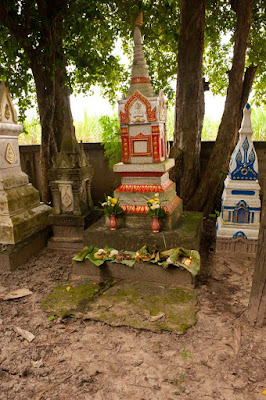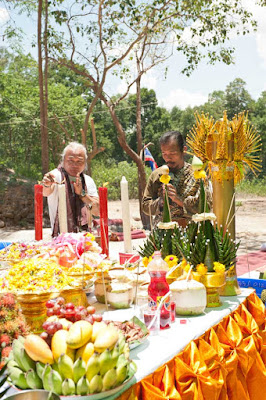We have been back from our one month trip to Connecticut for two weeks now and life is returning to normal for us. "Normal" does not necessarily mean routine but rather means the type of life that we enjoy. For Duang it means being able to practise her faith more completely and conveniently. For me it means being able to take advantage of the many opportunities here to photograph the details of Isaan culture.
On Thursday, July 28th my 67th birthday, Duang went to the local market to buy some of her foods. At the market, she learned of a special event that was happening later in the morning - the casting of a Naga statue at a nearby Wat.
Throughout Northeast Thailand and Lao People's Democratic Republic, concrete statues of Naga can be found at Wats often as handrails leading up to worship halls, as guardians at the gates to the grounds, or guardians at the entrance to worship halls and sometimes as part of a water or fountain feature of the Wat. Nagas are associated with the underwater world which the nearby Mekong River is closely associated with.
Naga is a mythological deity that takes the form a a very great snake. Nagas are found in the traditions and legends of Hinduism as well as in Buddhism. I have written before about the amalgamation of Animist, Hindu and Buddhist beliefs and traditions here in Isaan. The area was once Animist before Hindu and then Buddhist believers arrived. Today in Isaan traditions and beliefs from all three remain a very strong part of not only the culture but of individual daily life.
A long time ago, during one of Buddha's many reincarnations, this time as a toad, the rain god (King of the Sky), Phaya Tan (Taen) was angry with the people and animals. Buddha ( Phaya Khang Khok)'s, sermons were drawing people and creatures from earth and sky away from the King of the Sky. He decided to punish them by withholding the necessary life giving and sustaining rains. After seven years, seven months, and seven days of drought, the surviving people along with the animals got together and consulted with Buddha. After much deliberations, they decided that Phaya Nak (Naga), the giant snake, would lead them in war against the rain god, Phaya Tan. Phaya Tan defeated the giant snake and his troops. After eventually overcoming Phaya Tan, Buddha rewarded Phaya Nak (Naga) for his loyalty as well as service with the honor of being guardians.
When Buddha was walking around preaching and teaching his disciples, Naga The Serpent King (Phaya Nak) took on human form, asked to become a Monk, and followed Buddha around listening to the sermons.
One day the naga fell asleep and reverted back to his snake form. Buddha told him that he could not be a Monk because he was not of this world - only humans could be a Monk. The naga agreed to leave the Sanga (religious community of Monks) but requested a favor. He asked Buddha that all young men who are about to be ordained as Monks be called "nagas". Buddha agreed.
To prevent a recurrence of this incident, all young men as part of their ordination are asked if they are human. Phaya Nak, despite leaving the monkhood, continued his devotion to Buddha and is often depicted in art as the seven headed cobra shielding Buddha from the rain.
After checking out the sight, Duang returned home to see if I was interested. Naturally I was enthused at such an opportunity. I grabbed my camera gear and we set off accompanied by our daughter-in-law and 22 month old grandson, Pope.
A short distance from our home along a route that included two dirt single lane paths, we ended up at the sight of the Wat. This Wat is very rustic and primitive. The Monk's quarters are very basic - bamboo, wood, and thatched huts. The worship hall is a small building of similar construction.
The complex is a work in progress. A large statue of Buddha in the "Calling The Earth to Witness" pose had been recently been set upon a newly poured concrete block to still be completely backfilled. In this pose which defines the moment when Buddha became enlightened, Buddha is seated cross-legged with his left hand placed in his lap with the palm facing upwards, the right hand placed on his right knee with the fingers pointing down toward the Earth and the palm facing Buddha.
Upon arrival, we went to the building which serves as the worship hall. Inside some women were busy making pahn sii kwan, decorative centerpieces used in special rituals. Pahn are made from flowers, floral buds, and banana leaves and are a special handicraft of the ethnic Lao people of Thailand and Lao.
 |
| Pope Helping Out to Make A Pahn Sii Kwan |
After a while we went outside to where the Naga was to be cast. Sahts were placed upon the compacted moist ground for people to sit before a small shrine constructed for the day's ritual.
 |
| Monks Preparing Cement to Cast a Naga |
I then became aware that I would have the honor of pouring the first three buckets of cement for the statue. Was the honor because it was my birthday? Apparently not - the Monk did not know that it was my birthday until the next day. Was it because I was a foreigner, a falang? Yes! The land was once a horse farm frequented by foreigners and the husband of the landowner was a foreigner. Giving me the honor was considered good Karma for the place apparently.
 |
| Pope Places Some Coins In The Naga Form |
Coins were not the only objects placed inside of the Naga. After the lower portion of the Naga had been poured, the top sections of the formwork were attached. Just before the formwork was closed up with the last panel, the Abbott placed a special object inside of the void to be filled with cement. An intricate handcrafted Naga made from woven banana leaves and some type of organic fibers was unfurled and placed into the still wet cement of the lower base. The Naga might not have a heart but it would have a spirit and perhaps a soul.
 |
| Setting the Last Formwork Panel |
With the final panel installed, the pouring of cement recommenced and was quickly completed.
With the last bucket of cement poured, we said good bye to everyone and left the Wat with the Abbott making final adjustments to the formwork for the Naga's tongue.
We returned to our home satisfied and pleased; Duang satisfied and pleased at participating in as well as pleased with the merit that she earned for this special event. I was satisfied and pleased at having the opportunity to experience as well as documenting a unique cultural ritual.























































